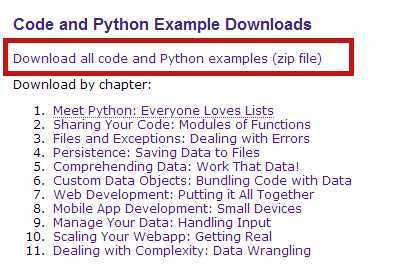标签:style blog class code java c
运用Python中的内置函数open()与文件进行交互
在HeadFirstPython网站中下载所有文件,解压后以chapter 3中的“sketch.txt”为例:

新建IDLE会话,首先导入os模块,并将工作目录却换到包含文件“sketch.txt”的文件夹,如C:\\Python33\\HeadFirstPython\\chapter3
>>> import os >>> os.getcwd() #查看当前工作目录 ‘C:\\Python33‘ >>> os.chdir(‘C:/Python33/HeadFirstPython/chapter3‘) #切换包含数据文件的文件夹 >>> os.getcwd() #查看切换后的工作目录 ‘C:\\Python33\\HeadFirstPython\\chapter3‘
打开文件“sketch.txt”,读取并显示前两行:
>>> data=open(‘sketch.txt‘) >>> print(data.readline(),end=‘‘) Man: Is this the right room for an argument? >>> print(data.readline(),end=‘‘) Other Man: I‘ve told you once.
回到文件起始位置,使用for语句处理文件中的每行,最后关闭文件:

>>> data.seek(0) #使用seek()方法回到文件起始位置 0 >>> for each_line in data: print(each_line,end=‘‘) Man: Is this the right room for an argument? Other Man: I‘ve told you once. Man: No you haven‘t! Other Man: Yes I have. Man: When? Other Man: Just now. Man: No you didn‘t! Other Man: Yes I did! Man: You didn‘t! Other Man: I‘m telling you, I did! Man: You did not! Other Man: Oh I‘m sorry, is this a five minute argument, or the full half hour? Man: Ah! (taking out his wallet and paying) Just the five minutes. Other Man: Just the five minutes. Thank you. Other Man: Anyway, I did. Man: You most certainly did not! Other Man: Now let‘s get one thing quite clear: I most definitely told you! Man: Oh no you didn‘t! Other Man: Oh yes I did! Man: Oh no you didn‘t! Other Man: Oh yes I did! Man: Oh look, this isn‘t an argument! (pause) Other Man: Yes it is! Man: No it isn‘t! (pause) Man: It‘s just contradiction! Other Man: No it isn‘t! Man: It IS! Other Man: It is NOT! Man: You just contradicted me! Other Man: No I didn‘t! Man: You DID! Other Man: No no no! Man: You did just then! Other Man: Nonsense! Man: (exasperated) Oh, this is futile!! (pause) Other Man: No it isn‘t! Man: Yes it is! >>> data.close()
读取文件后,将不同role对应数据分别保存到列表man和other:
import os print(os.getcwd()) os.chdir(‘C:\Python33\HeadFirstPython\chapter3‘) man=[] #定义列表man接收Man的内容 other=[] #定义列表other接收Other Man的内容 try: data=open("sketch.txt") for each_line in data: try: (role, line_spoken)=each_line.split(‘:‘, 1) line_spoken=line_spoken.strip() if role==‘Man‘: man.append(line_spoken) elif role==‘Other Man‘: other.append(line_spoken) except ValueError: pass data.close() except IOError: print(‘The datafile is missing!‘) print (man) print (other)
Tips:
使用open()方法打开磁盘文件时,默认的访问模式为r,表示读,不需要特意指定;
要打开一个文件完成写,需要指定模式w,如data=open("sketch.txt","w"),如果该文件已经存在则会清空现有内容;
要追加到一个文件,需要指定模式a,不会清空现有内容;
要打开一个文件完成写和读,且不清空现有内容,需要指定模式w+;
例如,将上例中保存的man和other内容以文件方式保存时,可修改如下:
1 import os 2 print(os.getcwd()) 3 os.chdir(‘C:\Python33\HeadFirstPython\chapter3‘) 4 man=[] 5 other=[] 6 7 try: 8 data=open("sketch.txt") 9 for each_line in data: 10 try: 11 (role, line_spoken)=each_line.split(‘:‘, 1) 12 line_spoken=line_spoken.strip() 13 if role==‘Man‘: 14 man.append(line_spoken) 15 elif role==‘Other Man‘: 16 other.append(line_spoken) 17 except ValueError: 18 pass 19 data.close() 20 except IOError: 21 print(‘The datafile is missing!‘) 22 23 try: 24 man_file=open(‘man.txt‘, ‘w‘) #以w模式访问文件man.txt 25 other_file=open(‘other.txt‘,‘w‘) #以w模式访问文件other.txt 26 print (man, file=man_file) #将列表man的内容写到文件中 27 print (other, file=other_file) 28 except IOError: 29 print (‘File error‘) 30 finally: 31 man_file.close() 32 other_file.close()
但是第26行print()为什么会报错?“syntax error while detecting tuple”
HeadFirstPython学习_从文件读取数据和保存数据,布布扣,bubuko.com
HeadFirstPython学习_从文件读取数据和保存数据
标签:style blog class code java c
原文地址:http://www.cnblogs.com/liutong3310/p/3727916.html